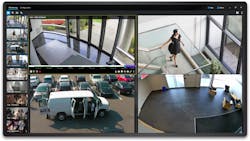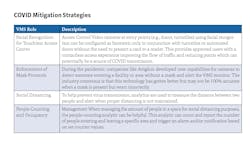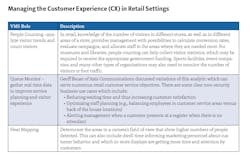When speaking to non-security industry persons about what security is or is not, I use a definition that involves managing risks against criminal and terrorist acts versus operational issues or national disasters. Most people would consider a video management system (VMS) as only a security mitigation strategy, but in fact it can also serve several non-security or business operational needs, which will be the focus of this article. For example, a VMS can assist in the following non-security business operations:
- COVID mitigation and facilitating a safer return to work
- Safety and reduction of on-the-job injuries
- Enhancing the customer experience (CX)
It is video analytics that commonly converts a camera from a passive security device to an active and important business operational tool. Video analytics apply algorithms or filters to images and video to find patterns or details in the pixels that represent an object (e.g., Person, Face, Vehicle), features (e.g., a nose, a mask, a vehicle), behaviors (e.g., people going to places they shouldn’t, personal protective equipment violations), and events (e.g., developing safety incidents such as fires, persons in restricted and unsafe areas, or vehicle accidents).
Prior to making a major investment in new systems to provide analytics, purchasers would be wise to field test analytics in the specific environment to verify analytic performance which may be challenged by local conditions such as poor or varying lighting and inclement weather.
COVID Mitigation Strategies
Organizations are in various stages of returning to full capacity at the workplace. COVID transmission is still a significant concern of business leaders, and video management systems can serve in a variety of ways as described in the table below.
Safety is the state of being away from hazards caused by natural forces or human errors. The VMS can be a valuable tool in the fight to keep illness and injury rates low, which in turn has a major impact on insurance and workers’ compensation costs. The table below defines some of the safety program benefits through the use of VMS assets at a site.
Managing the Customer Experience (CX) in Retail Settings
Chad Paris, A&E Consultant Program Manager of Hanwha summed it up nicely. “The use of analytics can expand beyond the security realm to support the business community through the use of people counting, cue line management and heatmap features. These advanced analytics can count the movement of people, alert when a checkout line extends beyond a determined amount of people and provide information and statics by timeline. The features can dramatically save user’s time, workforce, expenses and also help to create added value with consumer statistics.”
Vehicles and Traffic
- Detection (performed by the analytic) and notification of an irregularity,
- Assessment (performed by an employee with key responsibility and authority to correct the irregularity),
- Response (reacting and investigating the irregularity), and
- Interdiction (correcting the irregular condition)
By leveraging the power of the VMS for non-security purposes, security practitioners can make a better business case for the capital expense, or in the case of cloud video the operating expenses and show it as a value-added partner to leadership and the mission of an organization.
About the author:
Frank Pisciotta, CSC, is president of Business Protection Specialists, Inc., (https://www.securingpeople.com/physical-security-system-design/) a nationwide independent security consulting firm focused on risk identification, regulatory compliance and security design services. Pisciotta has managed more than 4,500 security-consulting engagements in his thirty-year consulting career. He possesses a master’s degree in public administration, a bachelor’s degree in criminal justice, and was board certified in Security Management by the American Society for Industrial Security as a Certified Protection Professional in 1994. He is also a Certified Security Consultant by the International Association of Professional Security Consultants. He can be reached at [email protected].
About the Author

Frank Pisciotta
Frank Pisciotta, CSC, is president of Business Protection Specialists, Inc
Frank Pisciotta is president of Business Protection Specialists, Inc., a global independent security consulting firm specializing in developing global security programs for multi-national organizations. The firm supports global clients with risk assessment and security design services including the specification of security technology in various sectors. Frank has managed over 5,500 security-consulting engagements in his more than thirty-five-year consulting career. Frank possesses a master’s degree in public administration and a bachelor’s degree in criminal justice and was board-certified in Security Management by the American Society for Industrial Security as a Certified Protection Professional in 1994. He is a past President of the International Association of Professional Security Consultants. Frank was the eighth person in the United States to achieve the Certified Security Consultant designation.


